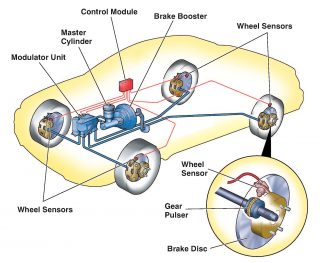Note: This is the part of a series of articles explaining some of the technical features of newer Honda and Toyota vehicles. We will explain, in plain English, how these highly complex systems work. Feel free to email us at moc.s1740154403krow-1740154403rotom1740154403@ofni1740154403 if you have any suggestions for things you’d like to learn about!
The Anti-Lock Braking System, or ABS, has become the cornerstone of modern vehicle safety systems. Unless you’ve just started driving recently, you’ll remember the days when we were taught to “pump the brakes” during a panic stop. But why is that?
In older vehicles without ABS, stomping on the brake pedal and holding it down almost always causes the wheels to “lock up” and begin skidding. Of course, when the car is skidding you have very little steering control. Pumping or “modulating” the brakes helps reduce the likelihood of locking up the brakes. That’s exactly what ABS does.
The earliest ABS design dates back to the 1920s for aircraft wheels. The modern implementation of ABS began in the 1970s and by the mid 1990s, most automakers were offering ABS. In 2013, the U.S. Department of Transportation mandated that all new vehicles sold in the United States include ABS and a similar and related system, Electronic Vehicle Stability Control.
So how does ABS work? Your vehicle’s on-board computer is constantly monitoring the rotational speed of each of the wheels using electronic sensors. When you apply the brakes, the computer is looking to see if one of the wheels is turning slower than the others, indicating it is about to lock up. The computer then momentarily releases the brake on that wheel then reapplies it when the speed matches the other wheels. This happens very rapidly (20-30 times per second) and you’ll notice a vibration in the brake pedal as the ABS engages.
What’s important to note, however, is that despite how you may have been taught years ago, pumping the brake pedal itself actually makes things worse now, since that disengages the ABS each time you release the pedal. So press and hold the pedal and do your best to steer around the obstacle!
Here’s a video from Mazda Australia (yeah, we know, not Honda or Toyota, but the concept is the same, plus the driver is on the “wrong” side of the car!) that explains more.

